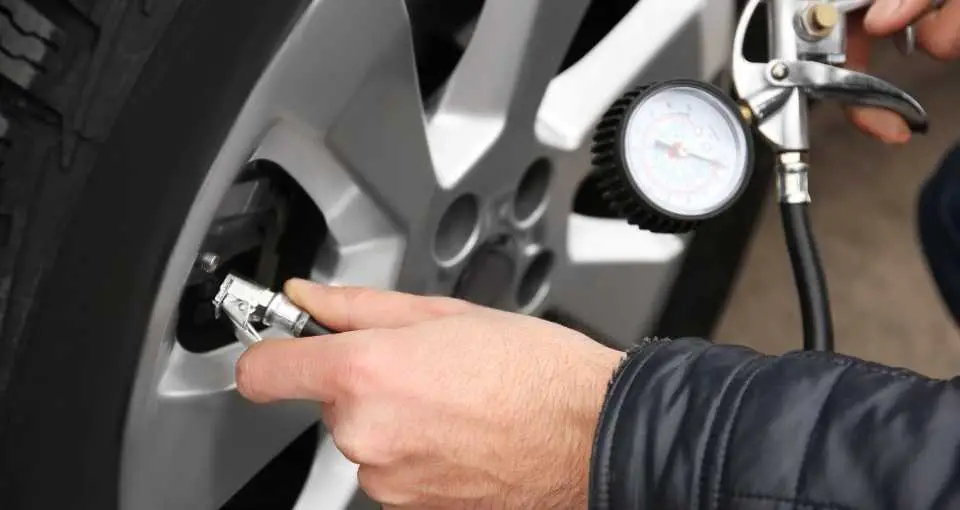The tire pressure for cars varies depending on the size and weight of the vehicle, the size of the wheels fitted to the vehicle, and in some instances, the type of tire fitted on the rim. While all these factors may determine what the correct pressure would be in your car tires, should all the tires on your car have the same air pressure?
All the tires on your car can have the same tire pressure, but this is not always the case. It usually depends on the size of your car and the load it is intended to carry. There is often a difference in the recommended tire pressure between the front and rear tires. The tires on the same axle, however, should both have the same air pressure.
The correct tire pressure can have an impact on the car’s handling, safety on the road, and the wear and tear that the tires sustain.
Car tire pressure and safety on the road go hand in hand, as does the wear on your tires. Cars can be used daily, used with different loads, and used on long and shorty trips.
Tire pressure can vary for these circumstances and require you to adjust the pressure for these occasions. So what is the correct pressure, and why is uneven pressure between tires a problem?
Read More: How Long Can A Spare Tire Last Unused?
Why Do Car Tires Need Different Pressure?
The tire pressures that are recommended for your car by the manufacturer of the car are generally located in the owner’s manual for the car, as well as on a sticker, which is usually located on the driver’s side inside the door jam.
The recommended pressures will be different for each vehicle, depending on the size of your vehicle and the intended carrying capacity of your vehicle.
If you have a smaller car, you may see only two sets of recommended air pressures, a minimum and a maximum, and the values may be the same for the front and rear tires. This is usually the case for smaller vehicles such as smaller sedans and hatchback vehicles.
If, however, your vehicle is an SUV or a pickup truck, you may see different values. With a larger, heavier vehicle, you may see a minimum and maximum for an unloaded vehicle and a minimum and maximum for the vehicle under load, and the front and rear pressures may differ in these cases.
A smaller car is intended to carry a load that does not exceed a certain maximum, and therefore the manufacturer deems it acceptable to have the front and back tires at the same pressure, and you can inflate all four tires to the maximum recommended pressure if you are transporting a particularly heavy load.
When it comes to an SUV or a pickup truck, the weight that the front axle bears is generally fairly constant, being the weight of the engine, mostly. The weight that the rear axle carries can, however, vary substantially depending on the weight being transported.
If you fill an SUV to its maximum people carrying capacity, it requires more air in the rear tires to cater to the increased load.
This principle applies even more to a pickup truck that is designed to take an even greater load in the load bed of the truck. The heavier the load, the more the rear tires need to be inflated to compensate for the additional weight.

Tire Myth: Over-inflating tires leads to better gas mileage. In reality you will get the best gas mileage by filling your tires to the manufacturers recommended tire pressure.
What Happens If The Tire Pressure Is Uneven?
Whether the manufacture recommends that all your tires have the same pressure on all four tires or whether there should be a difference between the front and rear tire pressure, you need to make sure the pressure is even.
What we mean by this is that the tire pressure in both tires on the same axle needs to be the same. For example, if the front tire pressure is designated to be 30 PSI, then both front tires should be inflated to 30 PSI.
If there is an imbalance in the pressure, it can affect the handling and safety of the vehicle. On a front-wheel drive, if one tire is inflated to the correct pressure and the other is not, it can affect the control of the vehicle around corners, and under heavy braking, the vehicle can pull to the side where the under-inflated tire is located.
If the vehicle is a load-carrying vehicle such as an SUV or a truck, and the rear tires have unbalanced inflation, it can cause the vehicle to be unstable when turning corners or going around bends in the road and can lead to the vehicle tipping over and rolling.
The instability and compromised road handling in these instances where the tire pressure is uneven are accentuated with speed. In other words, the faster you are going, the worse the problem becomes, and the faster the vehicle can become out of control.
Generally, a smaller car carrying a load would require you to add pressure to all four tires to compensate for the load. This is because, in a smaller wheelbase car, the load is more evenly distributed over both axles than in a longer wheelbase car.
How To Check Tire Pressure Correctly
The key to proper tire pressure is to check the pressure correctly and add the right amount of pressure, and the right tool to check tire pressure is a high-quality tire gauge. Don’t compromise on quality when you buy yourself a tire pressure gauge; good models are not very expensive and worth the difference in price compared to cheaper models.
A cheap gauge will be leaky and may not give you an accurate reading for your tires, which could be a significant problem for you as a motorist since this is literally where the rubber meets the road concerning you and your family’s safety!
The best time to check your car tire pressure is first thing in the morning when your car has been standing, and the temperature is cool. The manufacturer recommended pressures are cold pressures, which means the reading s should be taken when the tires are cold.
Driving your car creates friction on the tires, which heats up the air inside the tire. Taking a tire pressure reading when the tire is hot from driving or from standing in the sun can give you a significantly incorrect reading.
If you adjust your tire pressure according to this “hot” reading, you may inadvertently create an over-inflation or unbalanced inflation situation in your tires. This can not only compromise your vehicle’s safety but also affect the wear on the tires, shortening their lifespan.
Due to the best time to check tire pressure being in the morning before you set out on your drive, it is recommended that you have your own little portable air compressor for adjusting your tire pressure at home.
These little air compressor units are not only reasonably priced but are extremely convenient if you find yourself in the predicament of being stranded on the side of the road with a flat tire and your spare wheel is under-inflated! They are small and compact enough to be kept permanently in the trunk of your car, so it is available for any tire emergency or pressure adjustment.
The pressure gauges that come on the portable compressors are usually not of very high quality, so it is recommended that you have a separate, high-quality tire pressure gauge to check the pressure in your tires before and after adjustment with the compressor.
Tip: If you have a digital instrument panel (speed, fuel tank and mileage display). Then your car probably has the option display the current tire pressure readings digitally.
I would avoid viewing your tire pressure readings too often. As the readings are going to fluctuate all the time due to driving times and road conditions. It could drive you crazy (no-pun intended).
Conclusion
Some cars have the same tire pressures on the front and back tires, but other cars can have different inflation pressures between the front and rear tires.
The difference is usually determined by the size of the car and the load it is intended to carry. You will need to determine the tire pressure requirements for your particular car that the manufacturers recommend.
Once you have this information, it is up to you as a responsible and safe driver to check your car tire pressure and ensure that it is appropriate for your vehicle and the weight that you are transporting.
Having the right, good quality equipment will go a long way to making this important aspect of vehicle ownership an easy and accurate task that you can get done in a matter of a few minutes!
